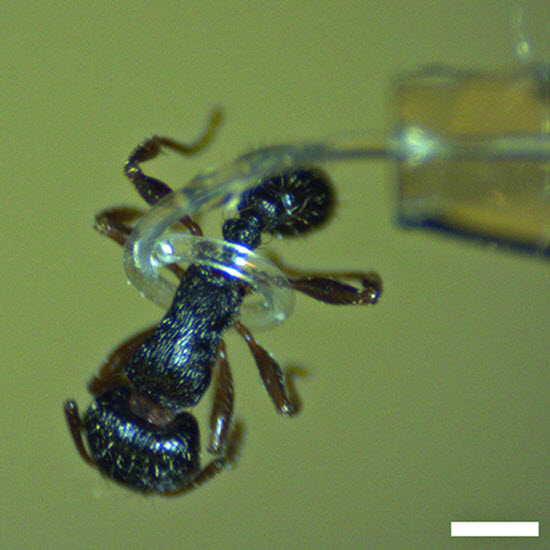Micro-tentacles for tiny robots can handle delicate objects like blood vessels
June 23, 2015

A micro-tentacle developed by Iowa State engineers spirals gently around an ant (credit: Jaeyoun (Jay) Kim/Iowa State University)
Iowa State University engineers have developed microrobotic tentacles that could allow small robots to safely handle delicate objects.
As described in an open-access research paper in the journal Scientific Reports, the tentacles are microtubes just a third of an inch long and less than a hundredth of an inch wide. They’re made from PDMS, a transparent elastomer that can be a liquid or a soft, rubbery solid.
“Most robots use two fingers and to pick things up they have to squeeze,” said Jaeyoun (Jay) Kim, an Iowa State University associate professor of electrical and computer engineering and an associate of the U.S. Department of Energy’s Ames Laboratory. “But these tentacles wrap around very gently.”
The researchers sealed one end of the tube and pumped air in and out. The air pressure and the microtube’s asymmetrical wall thickness created a circular bend. They then added a small lump of PDMS to the base of the tube to amplify the bend and create a two-turn spiraling, coiling action. The resulting soft-robotic micro-tentacle can wind around and hold fragile micro-objects.
“Spiraling tentacles are widely utilized in nature for grabbing and squeezing objects,” the engineers wrote in the paper. “There have been continuous soft-robotic efforts to mimic them… but the life-like, multi-turn spiraling motion has been reproduced only by centimeter-scale tentacles so far. At millimeter and sub-millimeter scales, they could bend only up to a single turn.”
Extending the reach of surgical robots
The micro-tentacle’s final spiral radius is about 200 micrometers (millionths of a meter), with a grabbing force in the vicinity of 0.78 millinewtons at 9.8 psi pneumatic pressure — weaker than those of existing elastomer-based pneumatic micro-actuators.
Kim said that makes the microrobotic tentacle ideal for medical applications because the microrobotic tentacles can’t damage tissues or even blood vessels.
The design also unites two current research areas, he said. “There’s microrobotics, where people want to make robots smaller and smaller. And there’s soft robotics, where people don’t want to make robots out of iron and steel. This project is an overlap of both of those fields. I want to pioneer new work in the field with both microscale and soft robotics.”
The study was supported by Kim’s six-year, $400,000 Faculty Early Career Development Award from the National Science Foundation.
No ants were harmed in testng the micro-tentacles, just really freaked out.
Abstract of Microrobotic tentacles with spiral bending capability based on shape-engineered elastomeric microtubes
Microscale soft-robots hold great promise as safe handlers of delicate micro-objects but their wider adoption requires micro-actuators with greater efficiency and ease-of-fabrication. Here we present an elastomeric microtube-based pneumatic actuator that can be extended into a microrobotic tentacle. We establish a new, direct peeling-based technique for building long and thin, highly deformable microtubes and a semi-analytical model for their shape-engineering. Using them in combination, we amplify the microtube’s pneumatically-driven bending into multi-turn inward spiraling. The resulting micro-tentacle exhibit spiraling with the final radius as small as ~185 μm and grabbing force of ~0.78 mN, rendering itself ideal for non-damaging manipulation of soft, fragile micro-objects. This spiraling tentacle-based grabbing modality, the direct peeling-enabled elastomeric microtube fabrication technique, and the concept of microtube shape-engineering are all unprecedented and will enrich the field of soft-robotics.